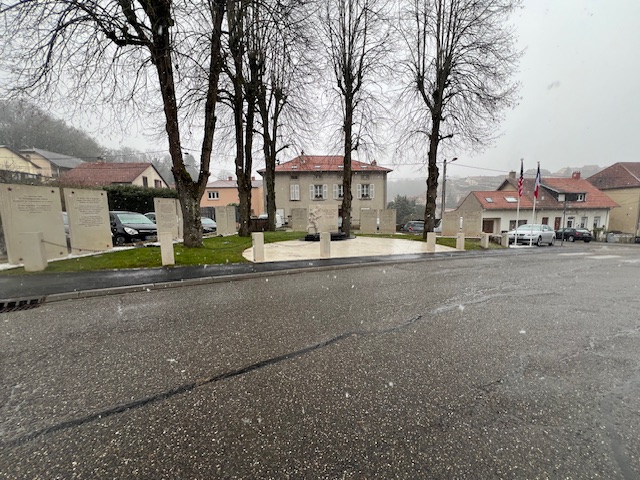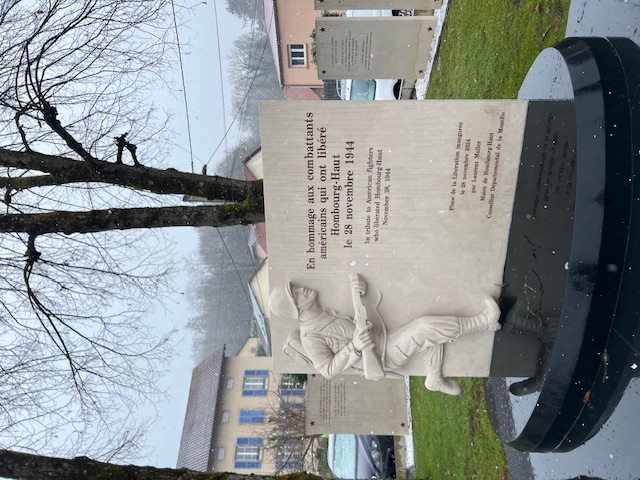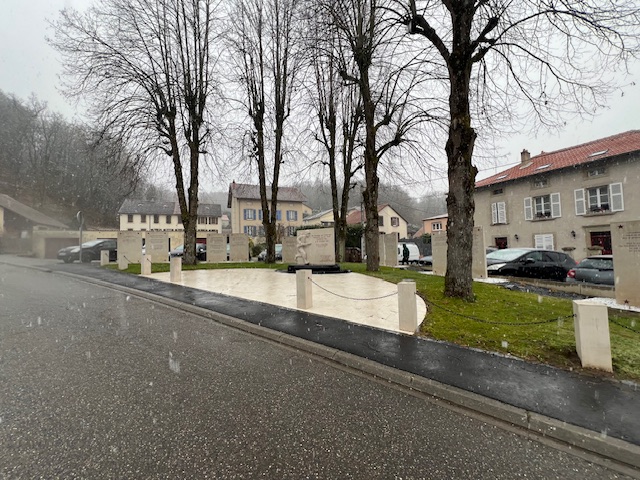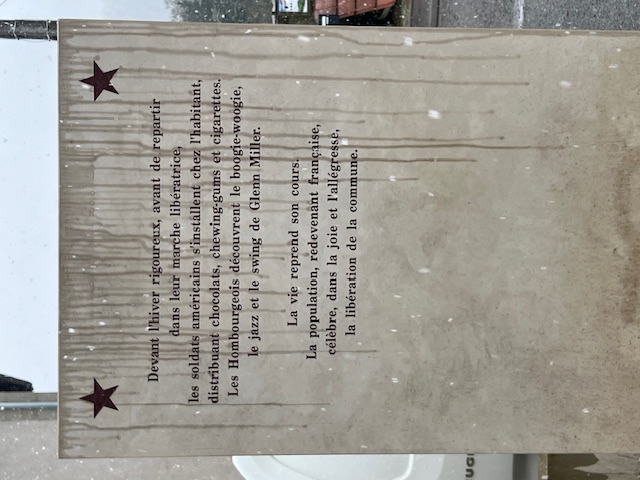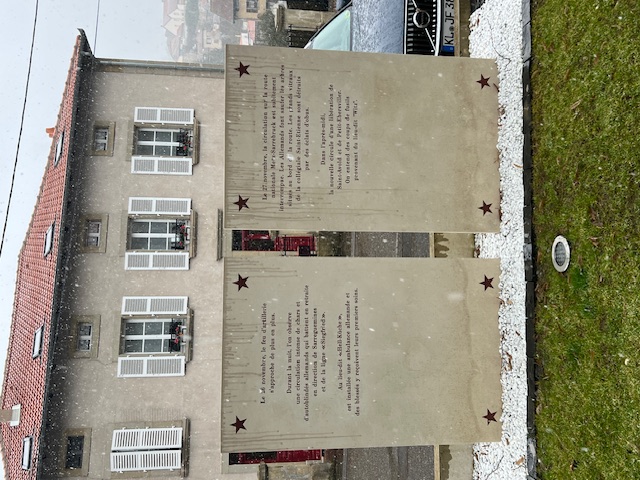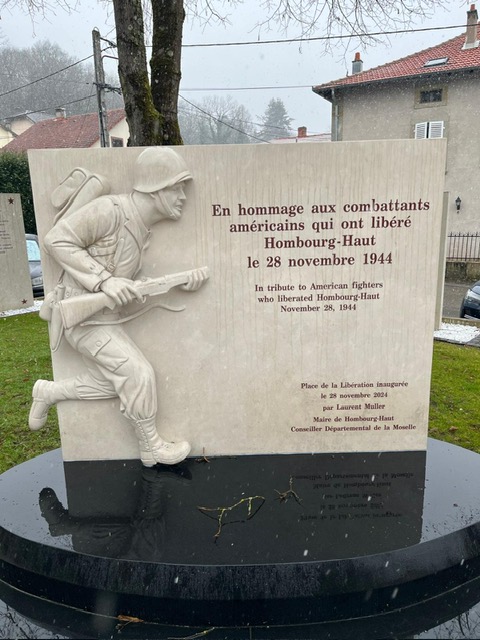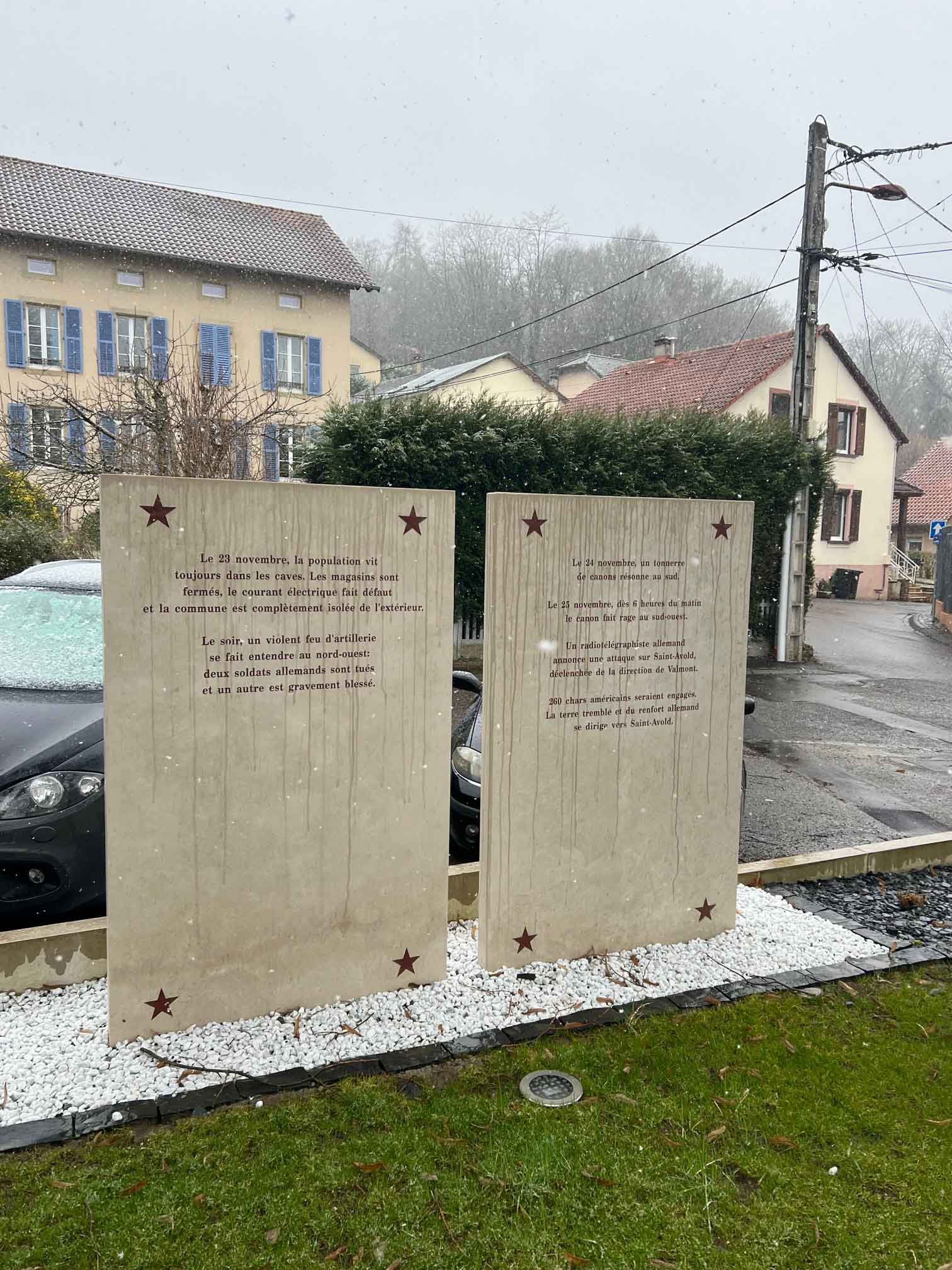Hombourg-Haut Liberation Memorial -80th Infantry Division
Details:
In front of the Liberation Square.
Monument
A central three-dimensional American soldier-inscribed monument; a series of inscribed marble square face the monument on two sides. The squares describe life for the local citizens through the war to include the libation of the town in November 1944. The town was liberated on November 28, 1944 by the 80th Infantry Division of the 3rd Army. The memorial was dedicated in November 2024 during the 80th Anniversary celebration of Liberation.
Monument Text:
Monument text :
En hommage aux combattants
américains qui ont libéré
Hombourg-Haut
le 28 novembre 1944
In tribute to American fighters
who liberated Hombourg-Haut
November 28, 1944
Panel text:
Le 23 novembre, la population vit
toujours dans les caves. Les magasins sont
fermés, le courant électrique fait défaut
et la commune est complètement isolée de l'extérieur.
Le soir, un violent feu d'artillerie
se fait entendre au nord-ouest :
deux soldats allemands sont tués
et un autre est gravement blessé.
English translation:
On November 23, the population was still living in cellars.
The shops were closed, there was no electricity, and the town was
completely isolated from the outside world.
That evening, heavy artillery fire
was heard to the northwest:
two German soldiers were killed and
another was seriously wounded.
Panel text:
Le 24 novembre, un tonnerre
de canons résonne au sud.
Le 25 novembre, dès 6 heures du matin
le canon fait rage au sud-ouest.
Un radiotélégraphiste allemand
annonce une attaque sur Saint-Avold,
déclenchée de la direction de Valmont.
260 chars américains seraient engagés.
La terre tremble et du renfort allemand
se dirige vers Saint-Avold.
English translation:
On November 24th, a thunder of cannon fire echoed to the south.
On November 25th, at 6:00 a.m., cannon fire raged to the southwest.
A German radio operator announced an attack on Saint-Avold, launched from the direction of Valmont.
260 American tanks were reportedly engaged. The earth trembled,
and German reinforcements headed toward Saint-Avold.
Panel text:
Le 26 novembre, le feu d'artillerie
s'approche de plus en plus.
Durant la nuit, l'on observe
une circulation intense de chars et
d'autoblindés allemands qui battent en retraite
en direction de Sarreguemines
et de la ligne « Siegfried ».
Au lieu-dit « Hell-Küche »,
est installée une ambulance allemande et
des blessés y reçoivent leurs premiers soins.
English translation:
On November 26, the artillery fire grew ever closer.
During the night, heavy traffic of German tanks and armored vehicles was observed, retreating towards Sarreguemines and the Siegfried Line.
At a place called Hell-Küche, a German ambulance was set up, and the wounded received first aid.
Panel text:
Le 27 novembre, la circulation sur la route
nationale Metz-Sarrebruck est subitement
interrompue. Les Allemands font sauter les arbres
situés au bord de la route. Les grands vitraux
de la collégiale Saint-Etienne sont détruits
par des éclats d'obus.
Dans l'après-midi,
la nouvelle circule d'une libération de
Saint-Avold et de Petit-Ebersviller.
On entend des coups de fusils
provenant du lieu-dit "Witz".
English translation:
On November 27, traffic on the Metz-Saarbrücken national road was suddenly interrupted. The Germans blew up the trees along the road. The large stained-glass windows of the Saint-Etienne collegiate church were destroyed by shell fragments.
In the afternoon, news spread of the liberation of Saint-Avold and Petit-Ebersviller. Gunfire was heard coming from the place called "Witz."
Panel text:
Les explosions s’éloignent de plus en plus.
Peu à peu, tout devient silencieux et, avec
impatience, l’on guette les premiers libérateurs.
Dans l’intimité des caves et maisons,
les gens préparent les drapeaux tricolores
pour pavoiser les rues à l’arrivée des troupes américaines.
English translation:
The explosions grew farther and farther away. Gradually, everything grew silent, and people eagerly awaited the first liberators.
In the privacy of their cellars and homes, people prepared the tricolor flags to fly on the streets upon the arrival of the American troops.
Panel text:
Le 28 novembre, dans la matinée,
l’on entend un grondement qui s’approche,
tandis que les avions d’observation
«Piper Cub» survolent Hombourg-Haut.
Les soldats américains de la 80ème division
de la 3ème Armée du Général Patton
font leur apparition dans la commune.
Ils descendent des deux côtés de la route
nationale en venant de Saint-Avold et
déblaient, au bulldozer, les arbres abattus
par les Allemands pour entraver la voie
et freiner leur progression.
English translation:
On the morning of November 28th, an approaching rumble was heard as Piper Cub observation planes flew over Hombourg-Haut.
American soldiers from the 80th Division of General Patton's Third Army appeared in the town.
They descended on both sides of the national road coming from Saint-Avold and used bulldozers to clear the trees cut down by the Germans to block the road and slow their advance.
Panel text:
Devant l’hiver rigoureux, avant de repartir
dans leur marche libératrice,
les soldats américains s’installent chez l’habitant,
distribuant chocolats, chewing-gums et cigarettes.
Les Hombourgeois découvrent le boogie-woogie,
le jazz et le swing de Glenn Miller.
La vie reprend son cours.
La population, redevenant française,
célèbre, dans la joie et l’allégresse,
la libération de la commune.
English translation:
Faced with the harsh winter, before setting off again on their liberation march, the American soldiers stayed in the homes of local residents, distributing chocolates, chewing gum, and cigarettes. The people of Homburg discovered boogie-woogie, jazz, and the swing of Glenn Miller.
Life returned to normal. The population, becoming French again,
celebrated the liberation of the town with joy and gladness.

